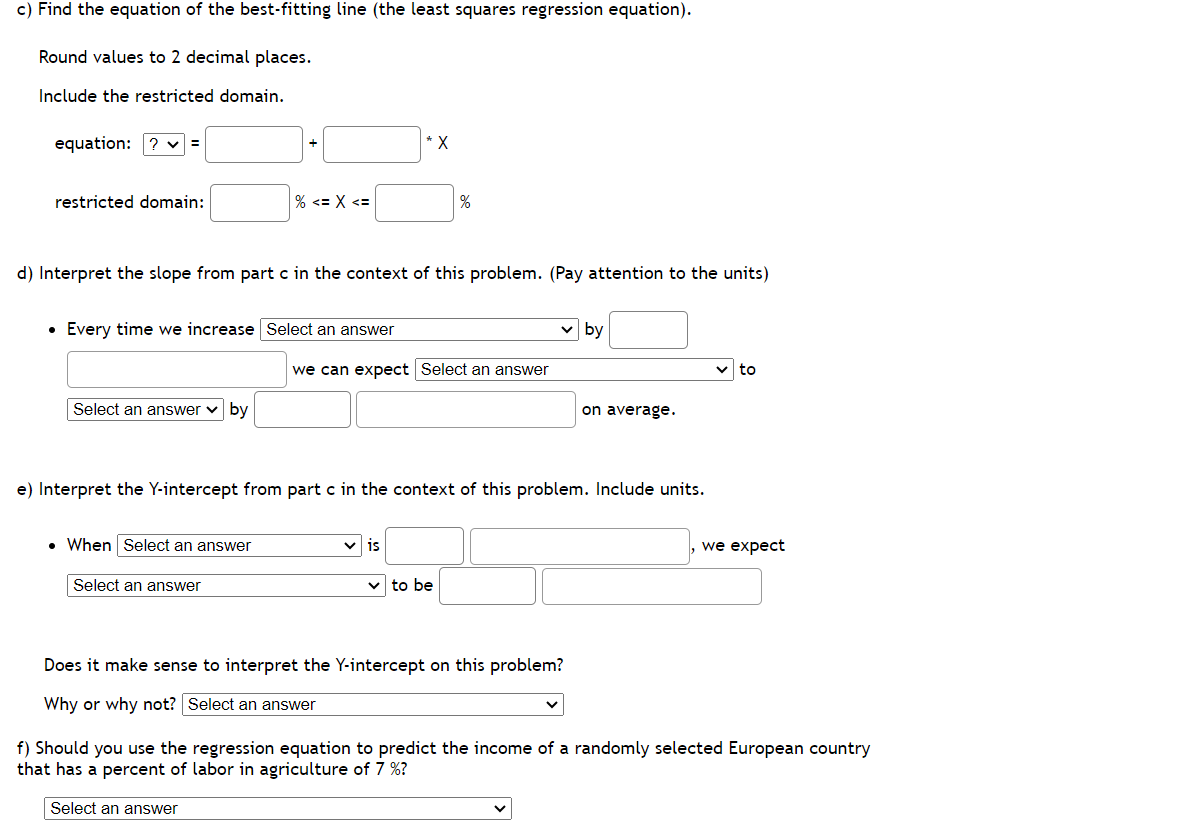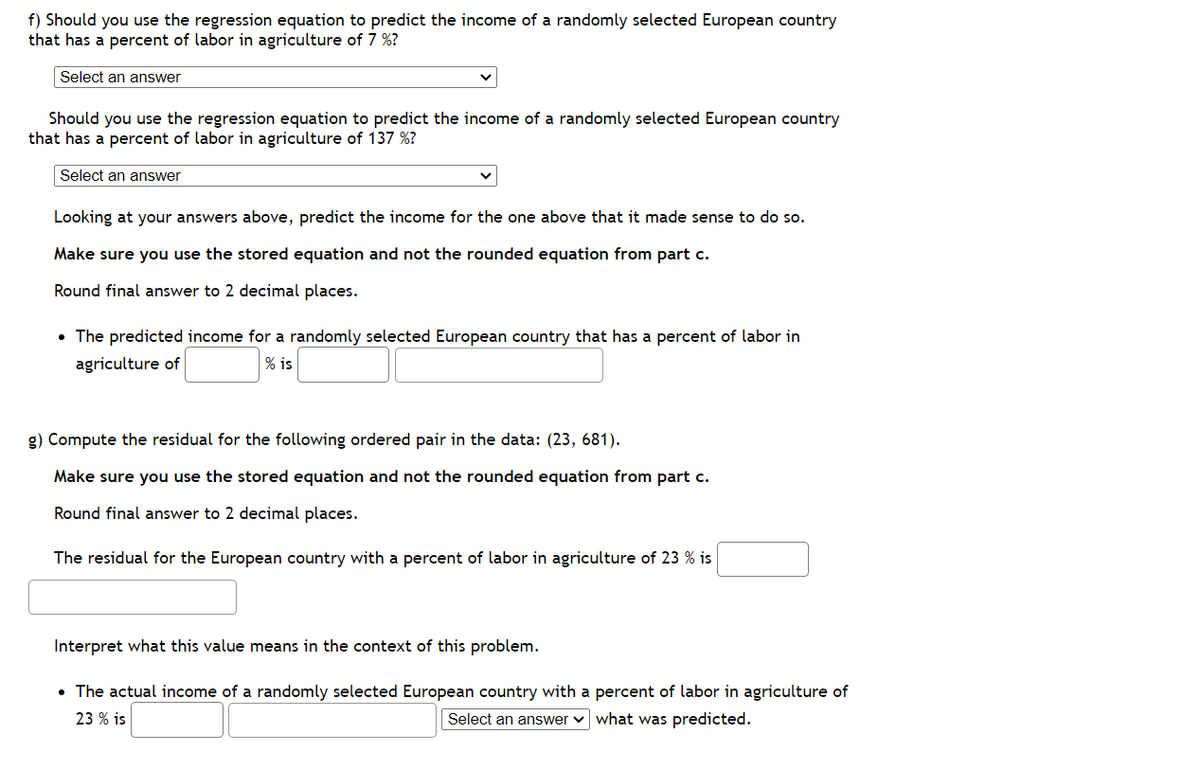Income (in 1960 dollars/person) for European countries and the percent of the labor force (in %) that works in agriculture in 1960 are in the table below ('OECD economic development,' 2013). X, percent of labor in agriculture (in %) Y, income (in 1960 dollars/person) 15 1242 56 324 20 977 42 290 11 1361 27 504 6 1005 79 177 23 681 11 810 18 1049 14 1644 20 1013 15 1035 25 839
Income (in 1960 dollars/person) for European countries and the percent of the labor force (in %) that works in agriculture in 1960 are in the table below ('OECD economic development,' 2013). X, percent of labor in agriculture (in %) Y, income (in 1960 dollars/person) 15 1242 56 324 20 977 42 290 11 1361 27 504 6 1005 79 177 23 681 11 810 18 1049 14 1644 20 1013 15 1035 25 839
Functions and Change: A Modeling Approach to College Algebra (MindTap Course List)
6th Edition
ISBN:9781337111348
Author:Bruce Crauder, Benny Evans, Alan Noell
Publisher:Bruce Crauder, Benny Evans, Alan Noell
Chapter3: Straight Lines And Linear Functions
Section3.CR: Chapter Review Exercises
Problem 15CR: Life Expectancy The following table shows the average life expectancy, in years, of a child born in...
Related questions
Question
Income (in 1960 dollars/person) for European countries and the percent of the labor force (in %) that works in agriculture in 1960 are in the table below ('OECD economic development,' 2013).
| X, percent of labor in agriculture (in %) | Y, income (in 1960 dollars/person) |
|---|---|
| 15 | 1242 |
| 56 | 324 |
| 20 | 977 |
| 42 | 290 |
| 11 | 1361 |
| 27 | 504 |
| 6 | 1005 |
| 79 | 177 |
| 23 | 681 |
| 11 | 810 |
| 18 | 1049 |
| 14 | 1644 |
| 20 | 1013 |
| 15 | 1035 |
| 25 | 839 |

Transcribed Image Text:c) Find the equation of the best-fitting line (the least squares regression equation).
Round values to 2 decimal places.
Include the restricted domain.
equation: ? =
restricted domain:
% <= x <=
• Every time we increase Select an answer
Select an answer by
d) Interpret the slope from part c in the context of this problem. (Pay attention to the units)
. When Select an answer
Select an answer
* X
%
we can expect Select an answer
✓is
e) Interpret the Y-intercept from part c in the context of this problem. Include units.
to be
Does it make sense to interpret the Y-intercept on this problem?
Why or why not? Select an answer
by
V
on average.
we expect
f) Should you use the regression equation to predict the income of a randomly selected European country
that has a percent of labor in agriculture of 7 %?
Select an answer

Transcribed Image Text:f) Should you use the regression equation to predict the income of a randomly selected European country
that has a percent of labor in agriculture of 7 %?
Select an answer
Should you use the regression equation to predict the income of a randomly selected European country
that has a percent of labor in agriculture of 137 %?
Select an answer
Looking at your answers above, predict the income for the one above that it made sense to do so.
Make sure you use the stored equation and not the rounded equation from part c.
Round final answer to 2 decimal places.
• The predicted income for a randomly selected European country that has a percent of labor in
agriculture of
% is
g) Compute the residual for the following ordered pair in the data: (23, 681).
Make sure you use the stored equation and not the rounded equation from part c.
Round final answer to 2 decimal places.
The residual for the European country with a percent of labor in agriculture of 23 % is
Interpret what this value means in the context of this problem.
• The actual income of a randomly selected European country with a percent of labor in agriculture of
23 % is
Select an answer ✓ what was predicted.
Expert Solution
This question has been solved!
Explore an expertly crafted, step-by-step solution for a thorough understanding of key concepts.
This is a popular solution!
Trending now
This is a popular solution!
Step by step
Solved in 3 steps

Recommended textbooks for you

Functions and Change: A Modeling Approach to Coll…
Algebra
ISBN:
9781337111348
Author:
Bruce Crauder, Benny Evans, Alan Noell
Publisher:
Cengage Learning

Algebra and Trigonometry (MindTap Course List)
Algebra
ISBN:
9781305071742
Author:
James Stewart, Lothar Redlin, Saleem Watson
Publisher:
Cengage Learning

Elementary Linear Algebra (MindTap Course List)
Algebra
ISBN:
9781305658004
Author:
Ron Larson
Publisher:
Cengage Learning

Functions and Change: A Modeling Approach to Coll…
Algebra
ISBN:
9781337111348
Author:
Bruce Crauder, Benny Evans, Alan Noell
Publisher:
Cengage Learning

Algebra and Trigonometry (MindTap Course List)
Algebra
ISBN:
9781305071742
Author:
James Stewart, Lothar Redlin, Saleem Watson
Publisher:
Cengage Learning

Elementary Linear Algebra (MindTap Course List)
Algebra
ISBN:
9781305658004
Author:
Ron Larson
Publisher:
Cengage Learning


Glencoe Algebra 1, Student Edition, 9780079039897…
Algebra
ISBN:
9780079039897
Author:
Carter
Publisher:
McGraw Hill